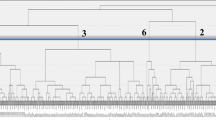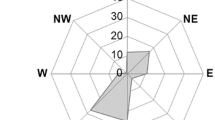Abstract
This paper discusses the characteristic air mass types over the Carpathian Basin in relation to plant pollen levels over annual pollination periods. Based on the European Centre for Medium-Range Weather Forecasts dataset, daily sea-level pressure fields analysed at 00 UTC were prepared for each air mass type (cluster) in order to relate sea-level pressure patterns to pollen levels in Szeged, Hungary. The database comprises daily values of 12 meteorological parameters and daily pollen concentrations of 24 species for their pollination periods from 1997 to 2001. Characteristic air mass types were objectively defined via factor analysis and cluster analysis. According to the results, nine air mass types (clusters) were detected for pollination periods of the year corresponding to pollen levels that appear with higher concentration when irradiance is moderate while wind speed is moderate or high. This is the case when an anticyclone prevails in the region west of the Carpathian Basin and when Hungary is under the influence of zonal currents (wind speed is high). The sea level pressure systems associated with low pollen concentrations are mostly similar to those connected to higher pollen concentrations, and arise when wind speed is low or moderate. Low pollen levels occur when an anticyclone prevails in the region west of the Carpathian Basin, as well as when an anticyclone covers the region with Hungary at its centre. Hence, anticyclonic or anticyclonic ridge weather situations seem to be relevant in classifying pollen levels.





Similar content being viewed by others
References
Adamopoulos AD, Kambezidis HD, Zevgolis D (2002) Case studies of total NO2 column in the atmosphere of Athens, Greece: Comparison between summer and winter. Fresen Environ Bull 11:484–487
Anderberg MR (1973) Cluster analysis for applications. Academic Press, New York
Bartzokas A, Metaxas DA (1993) Covariability and climatic changes of the lower troposphere temperatures over the Northern Hemisphere. Nouvo Cimento C 16C:359–373
Bartzokas A, Metaxas DA (1995) Factor analysis of some climatological elements in Athens, 1931–1992: covariability and climatic change. Theor Appl Climatol 52:195–205
Borhidi A (1995) Social behaviour types, the naturalness and relative ecological indicator values of the higher plants in the Hungarian Flora. Acta Bot Hun 39:97–181
D’Amato G (2000) Urban air pollution and plant-derived respiratory allergy. Clin Exp Allergy 30:628–636
Damialis A, Gioulekas D, Lazopoulou C, Balafoutis C, Vokou D (2005) Transport of airborne pollen into the city of Thessaloniki: the effects of wind direction, speed and persistence. Int J Biometeorol 49/3:139–145
Ellenberg H, Weber HE, Düll R, Wirth V, Werner W, Paulissen D (1991) Zeigerwerte von Pflanzen in Mitteleuropas. Scripta Geobot 18: Goltze Verlag, Göttingen
Fornaciari M, Bricchi E, Greco F, Fascini D, Giannoni C, Frenguelli G, Romano B (1992) Daily variations of Urticaceae pollen count and influence of meteoclimatic parameters in East Perugia during 1989. Aerobiologia 8:407–413
Galán C, Alcázar P, Cariòanos P, Garcia H, Domínguez-Vilches E (2000) Meteorological factors affecting daily Urticaceae pollen counts in southwest Spain. Int J Biometeorol 43:191–195
Geller-Bernstein C, Kenett R, Waisel Y (1996) Aerobiology in the prevention of allergy. In: Tariq SM, Emberlin J (eds) Clinical applications of aerobiology. Braine-L’Alleud, The UCB Institute for Allergy pp 69–75
Geller-Bernstein C, Lahoz C, Cárdaba B, Hassoun G, Iancovici-Kidon M, Kenett R, Waisel Y (2002) Is it “bad hygiene” to inhale pollen in early life? Allergy 57/71:37
Giner MM, Carrión Garcia JS, Garcia Sellés J (1999) Aerobiology of Artemisia airborne pollen in Murcia (SE Spain) and its relationship with weather variables: annual and intradiurnal variations for three different species. Wind vectors as a tool in determining pollen origin. Int J Biometeorol 43:51–63
Gioulekas D, Balafoutis C, Damialis A, Papakosta D, Gioulekas G, Patakas, D (2004) Fifteen years’ record of airborne allergenic pollen and meteorological parameters in Thessaloniki, Greece. Int J Biometeorol 48/3:128–136
Golder D (1972) Relations among stability parameters in the surface layer. Boundary Layer Meteor 3:47–58
Green BJ, Dettmann M, Yli-Panula E, Rutherford S, Simpson R (2004) Atmospheric Poaceae pollen frequencies and associations with meteorological parameters in Brisbane, Australia: a 5-year record, 1994–1999. Int J Biometeorol 48/4:172–178
Hair JF, Anderson RE, Tatham RL, Black WC (1998) Multivariate data analysis, 5th edn. Prentice Hall, New Jersey, p 730
Horváth F, Dobolyi ZK, Morschhauser T, Lõkös L, Karas L, Szerdahelyi T (1995) Flora database 1.2. Ecological and Botanical Institute of the Hungarian Academy of Sciences (in Hungarian), Vácrátót
Járai-Komlódi M (1998) Ragweed in Hungary. In: Spieksma F Th M (ed) Ragweed in Europe. Satellite Symposium Proceedings of 6th International Congress on Aerobiology, Perugia, Italy. Alk Abelló A/S, Horsholm, Denmark pp 33–38
Jolliffe IT (1990) Principal component analysis: a beginner’s guide. I. Introduction and application. Weather 45:375–382
Jolliffe IT (1993) Principal component analysis: a beginner’s guide. II. Pitfalls, myths and extensions. Weather 48:246–253
Juhász M (1995) New results of aeropalynological research in Southern Hungary. Publications of the Regional Committee of the Hungarian Academy of Sciences, Szeged 5:17–30
Kalkstein LS, Tan G, Skindlov JA (1987) An evaluation of three clustering procedures for use in synoptic classification. J Climate Appl Meteorol 26:717–730
Kambezidis HD, Weidauer D, Melas D, Ulbricht M (1998) Air quality in the Athens basin during sea breeze and non-sea breeze days using laser-remote-sensing technique. Atmos Environ 32:2173–2182
Käpylä M, Penttinen A (1981) An evaluation of the microscopial counting methods of the tape in Hirst-Burkard pollen and spore trap. Grana 20:131–141
Makra L, Kiss Á, Palotás J (1985) The spatial and temporal variability of drought in the southern part of the Great Hungarian Plain. Acta Clim Univ Szegediensis 18–20:65–85
Makra L, Horváth Sz, Sümeghy Z (2002) An objective analysis and ranking of cities on environmental and social factors. IGU 2002. Geographical Renaissance at the Dawn of the Millennium. In: Nkemdirim LC (ed) Climates in transition. Minuteman, Durban, South-Africa, pp 161–172
Makra L, Juhász M, Béczi R, Borsos E (2004a) The history and impacts of airborne Ambrosia (Asteraceae) pollen in Hungary. Grana 44:57–64
Makra L, Juhász M, Borsos E, Béczi R (2004b) Meteorological variables connected with airborne ragweed pollen in Southern Hungary. Int J Biometeorol 49:37–47
Makra L, Mika J, Bartzokas A, Béczi R, Borsos E Sümeghy Z (2006) An objective classification system of air mass types for Szeged, Hungary with special interest to the levels of the main air pollutants. Meteorol Atmos Phys 92/1-2:115–137
McGregor GR, Bamzelis D (1995) Synoptic typing and its application to the investigation of weather - air pollution relationships, Birmingham, United Kingdom. Theor Appl Climatol 51:223–236
Mezei G, Járai-Komlódi M, Papp E, Cserháti E (1992) Late summer pollen and allergen spectrum in children with allergic rhinitis and asthma in Budapest. Pädiatrie Pädologie 27/3:75
Mohl M, Gaskó B, Horváth Sz, Makra L, Szabó F (2002) 2nd Environmental Programme of Szeged, 2003–2007. Manuscript (in Hungarian) (Mayor’s Office, H-6720 Szeged, Széchenyi tér 10, Hungary)
Pasquill F (1962) Atmospheric diffusion. Van Nostrand, London p 209
Péczely G (1957) Grosswetterlagen in Ungarn. Kleinere Veröffentlichungen der Zentralanstalt für Meteorologie Budapest 30:86, Budapest
Péczely G (1979) Climatology (in Hungarian). Tankönyvkiadó, Budapest, p 336
Péczely G (1983) Catalogue of the macrosynoptic types for Hungary (1881–1983) (in Hungarian). Hungarian Meteorological Service 53:116, Budapest
Rodríguez-Rajo FJ, Frenguelli G, Jato MV (2003) Effect of air temperature on forecasting the start of the Betula pollen season at two contrasting sites in the south of Europe (1995–2001). Int J Biometeorol 47/3:117–125
Rodríguez-Rajo FJ, Dacosta N, Jato V (2004a) Airborne olive pollen in Vigo (Northwest Spain): a survey to forecast the onset and daily concentrations of the pollen season. Grana 43/2:101–110
Rodríguez-Rajo FJ, Iglesias I, Jato, V (2004b) Allergenic airborne pollen monitoring of Vigo (NW Spain) in 1995–2001. Grana 43/3:164–173
Sindosi OA, Katsoulis BD, Bartzokas A (2003) An objective definition of air mass types affecting Athens, Greece; the corresponding atmospheric pressure patterns and air pollution levels. Environ Technol 24:947–962
Stennett PJ, Beggs PJ (2004) Pollen in the atmosphere of Sydney, Australia, and relationships with meteorological parameters. Grana 43/4:209–216
Turner DB (1964) A diffusion model for an urban area. J Appl Meteorol 3:83–91
Vázquez LM, Galán C, Domínguez-Vilches E (2003) Influence of meteorological parameters on olea pollen concentrations in Córdoba (South-western Spain). Int J Biometeorol 48/2:83–90
Acknowledgements
The authors thank the Department of Analysis and Methodology, Hungarian Meteorological Service for providing the sea-level pressure data for the investigated period, Gábor Motika (Environmental Protection Inspectorate of Lower-Tisza Region, Szeged, Hungary) for handling meteorological and air pollution data and Áron Deák József for advice on plant ecology. This study was supported by the Hungarian National Foundation for Scientific Research (OTKA No. T 034765).
Author information
Authors and Affiliations
Corresponding author
Rights and permissions
About this article
Cite this article
Makra, L., Juhász, M., Mika, J. et al. An objective classification system of air mass types for Szeged, Hungary, with special attention to plant pollen levels. Int J Biometeorol 50, 403–421 (2006). https://doi.org/10.1007/s00484-006-0026-y
Received:
Revised:
Accepted:
Published:
Issue Date:
DOI: https://doi.org/10.1007/s00484-006-0026-y




